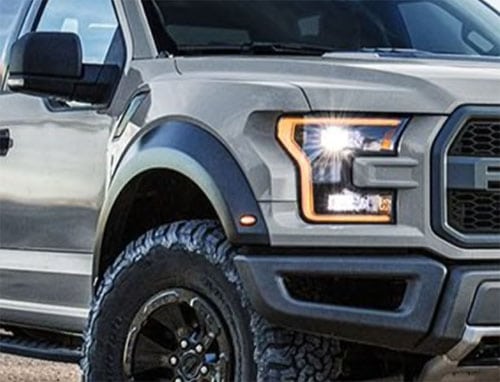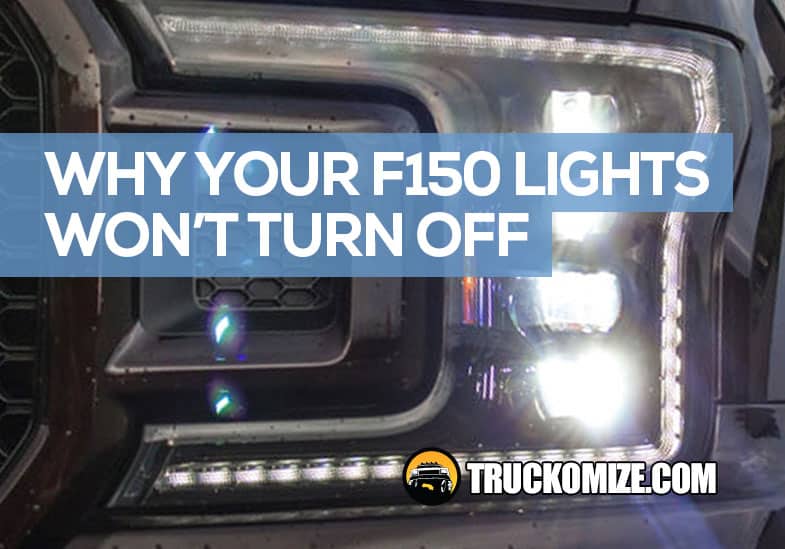There is an occasional reported problem with Ford F150s when the headlights stay on, or even come on. This can be despite the key being out of the ignition, and the truck locked. If the lights on your Ford F150 won’t turn off it could be due to a few reasons, outlined below with solutions.
Why won’t my F150 lights turn off? Your F150’s lights might not turn off due to a problem with the headlight switch or the faulty engagement of daytime running lights (DRL) including a faulty fuse.
That’s the very simple answer to why your Ford F150’s lights don’t turn off, but there could be more to it. Read on to see how you can solve the problem of why your F150 headlights stay on.
Why won’t my F150 lights turn off (reasons & fixes)
To find out why your F150 still has the lights on, you will need to go through a little trial and error troubleshooting. Here are the possibilities to explore and exclude and then how to fix each one.
Possibility 1: Faulty headlight switch
This tends to be the most likely reason for your F150’s headlight remaining on. If you’re not familiar with it, the headlight switch or dimmer switch helps in regulating your truck’s headlight functions. The switch lets you toggle the F150’s low and high beam modes.
It usually works great, but if it is broken or faulty, it will confine its operations to a fixed mode or result in an erratic headlight operation as you drive. In that broken or malfunctioning state, your lights may stay on even when you don’t need them on.
Thankfully it’s not a fix that requires high level expertise, and you might be able to fix your headlights staying on by yourself. You should be able to easily replace the switch and restore your headlights to their previous best working selves.
The fix only takes a few minutes and doesn’t demand any special tools or expertise. The easy-to-follow steps involved are:
How to fix F150 lights that stay on if a faulty headlight switch
- Disconnect the battery cable. You can use a wrench, but make sure the engine is off before you do it.
- Now look under the steering wheel for two screws below the steering column. Remove those to expose the headlight switch.
- You can now unscrew the headlight switch from the steering column bracket.
- Unplug the wiring block from the headlight switch. Check they are clean with no dust or debris on them. If they are dirty, give them a wipe and replace them back in.
- Test.
If the switch is broken, you need a purchase a new one. You can buy them on Amazon the last time I looked. Once fitted with a new headlight switch, your Ford F150 should stop misbehaving and leaving the lights on.
However, if the lights still don’t turn off after looking into the headlight switch, we need to perform a deeper diagnosis…

Possibility 2: Corroded wiring or fuses
If damp gets into the electrics, it can short the light switches, occasionally meaning the headlights stay on.
For example, if rain comes in through a windshield leak and the water gets into the dashboard fuse box, it can corrode wires and blow fuses.
This can happen if you have a leaky seal in your windshield. You can get it re-sealed once you replace and wiring and fuses.
Possibility 3: Misapplied daytime running lights
The next possible reason why your Ford F150’s headlights are staying on could relate to the daytime running light (DRL) technology. These are present in more recent models of the F150.
Daytime running lights (DRLs) are designed to make your vehicle more visible in bright, daytime conditions. They should come on automatically when you start your engine. (The AA, What are daytime running lights)
These are in the F150 to help mitigate the risk of accidents so should not be switched off but could be faulting to leave your lights on after you switch the ignition off.
Depending on your F150 trim, you may encounter either a configurable or a non-configurable DRL system. Failure to understand both these systems correctly may be the reason your F150 lights won’t turn off when you expect them to.
So, how does DRL function?
You can either automate the lights using the lights control switch or manually control them through the instrument cluster screen in your truck. Think of it as a control panel with a digital information display allowing you to set your vehicle’s lighting preferences.
Whenever you are driving and set the lighting control to the auto lamp dial, the daytime running lights will automatically turn on if your headlights are off. Once this has been activated, the lights will then occasionally switch between the headlamps and the DRL accordingly.
That will depend on the extent of exterior light or darkness engulfing the truck at any time during driving.
With that in mind, it is also possible to turn off the daytime running lights through the preference settings on the instrument cluster display. When this happens, your DRL will not come on at all whether you set your lights control switch to the auto lamp symbol.
How do you activate and deactivate F150’s daytime running lights?
To stay in control of your F150’s lighting functionality, mastery of the DRL system is imperative. That includes learning how to enable and disable the system to eliminate the shock when the lights stay on continuously.
Using the information system on your dashboard display, you can easily change the settings. On the screen, touch on “Settings”. This opens a new menu box. Touch “Vehicle Settings” in the new window. Then, proceed to “Lighting” which leads to a final DRL window. On this window, you can enable or disable “Daytime Running Lights” as appropriate.
In a nutshell, the daytime running lamps will only come on when:
- Your F-150 truck is on.
- You enable the DRL system.
- You set the lighting control to the auto lamp symbol.
- You turn off your headlights.
- You disengage the parking (P) mode in automatic transmission trucks or release the emergency brake in manual transmission trucks.
More on the F150’s daytime running lights
Not all F150 trucks come standard with a configurable DRL system. That means you cannot disable DRL in such vehicles. If you are operating any of such non-configurable models, your daytime running lights will always be on except you turn on the headlights or set your truck in park (P) mode.
The Ford F150 models typical of this behavior are those imported or assembled in Canada. This has been necessitated by local regulations mandating all motorists to leave their DRLs on while driving.
Having said that, with all the hype heaped on daytime running lamps, it is easy to delegate all the visibility responsibility to them hoping they’ll magically announce your presence to fellow road users.
On the contrary, however, the DRL system doesn’t affect the rear lights and by itself, may not provide ample lighting in low visibility conditions. That means you should always switch your headlamps on as needed whenever driving in poorly lit conditions.
What else you should know about the F150 lighting system
As a responsible F150 driver, you should be a master of your own tool of trade. Whether you use your truck for fun or work, you cannot drive around without a good grip on the truck’s lighting operation.
Here are some questions and answers to enlighten you further.
Handy Hint: Here’s why your F150 started to jerk and buck when you hit the gas pedal.
Why are my Ford F150 parking lights not working?
Faulty parking lights in your F150 may be attributable to several electrical components tied to the lights. If not the bulbs themselves, the headlight switch, wiring harness, or the fuses may be the problem.
Sometimes fixing the problem may be as straightforward as simply replacing the non-functioning headlight bulb. Switch on the headlights and attempt to replace any of the bulbs that do not turn on.
Then, detach the wiring harness and delink the retaining clip before extracting the bulb. Next, attach the replacement bulb, clip it, and restore the wiring harness. Test the headlamps and if they fail, proceed to the wiring diagnosis.
How do you switch off the cargo lights in a F150?
Simply locate the cargo lights button sitting by the steering wheel’s left side. On the left side, identify the bottom button adjacent to the light’s rotary knob. Alternatively, the lights will automatically go off after a few minutes or when driving beyond 3mph.
Why are my F150’s lights flickering?
A blinking drive light might have something to do with an electrical fault. That means if the transmission stick shifts normally, you may be staring at a wiring hitch.
My interior F150 dome light won’t turn off
If your F150’s dome or interior ceiling light fails or won’t turn off, either your dimmer switch or bulb could be faulty. To rule out a problem with the bulb, fix another functioning bulb and test its operation. Then, see if the dimmer switch’s integrity is intact.
If you successfully rule out these two possibilities, you could be dealing with a malfunctioned fuse somewhere in the wiring.
Where is the light sensor on a Ford F150?
The Ford F150 light sensor sits right at the heart of the dashboard close to the windshield. Based on the available ambient light, the sensor turns on the headlight in case of dim ambient light and off in case of a bright surrounding.
What if the lights stay on yet the truck can’t start?
The very fact that the lights come on is indicative of a partially charged battery. Therefore, the car’s failure to start may be attributed to something other than the battery. It might be that the truck’s ignition or starter has malfunctioned.
That said, the issue could still point back to weak battery power. If you cannot diagnose and troubleshoot the problem with precision, you might want to get hold of a mechanic to clear the guesswork.
Conclusion
While the Ford F150 is a great ride, with later models coming equipped with modern lighting sophistication, you might encounter the occasional error where the F150 headlights don’t turn off.
Hopefully these tips let you better understand how to switch the lights off if you ever get any faults like this.
You might also like…
Do you own a Ford F-150 truck? You might want to take a back seat as I walk you through some more occasional problems and fixes you might encounter on the links below.


